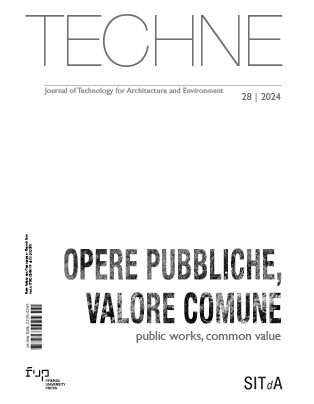Published 2024-10-29
Keywords
- Planning,
- Building process,
- Equitable and inclusive regeneration,
- Playgrounds,
- Green infrastructure
How to Cite
Copyright (c) 2024 Adolfo F. L. Baratta, Laura Calcagnini

This work is licensed under a Creative Commons Attribution 4.0 International License.
Abstract
The European Community has adopted a contractual-performance mode of managing community funds, in which the funding disbursement is contingent on the achievement of specific measured results. This has conditioned the NRP Programmes and had positive repercussions on national ones. Among these, the “Dateci Spazio” Programme (literally “Give us space”) is part of a broad process of equitable and inclusive regeneration of urban habitats and green infrastructure, promoting the creation of playgrounds in municipalities with populations over 300,000. The paper returns application research aimed at defining a process and tools to implement this experimental Programme generating accessible, inclusive, and universal habitats.
Downloads
References
- Baratta, A.F.L., Calcagnini, L., Finucci, F. and Magarò, A. (2023), “Innovative housing policy tools: impact indicators in the NRRP Urban Regeneration Programmes”, VITRUVIO International Journal of Architectural Technology and Sustainability, n. 8(1), pp. 58-69. Available at: https://doi.org/10.4995/vitruvio-ijats.2023.19476. DOI: https://doi.org/10.4995/vitruvio-ijats.2023.19476
- Bento, G. and Dias, G. (2017), “The importance of outdoor play for young children’s healthy development”, Porto Biomedical Journal, n. 2(5), pp. 157-160. Available at: https://doi.org/10.1016/j.pbj.2017.03.003. DOI: https://doi.org/10.1016/j.pbj.2017.03.003
- Brown, S. and Vaughan, C. (2009), Play: How It Shapes the Brain, Opens the Imagination and Invigorates the Soul, Avery Publishing Group, New York.
- De Haas, W., Hassink, J. and Stuiver, M. (2021), “The role of urban green space in promoting inclusion: experiences from the Netherlands”, Frontiers in Environmental Science, n. 9, 618198. Available at: https://doi.org/10.3389/fenvs.2021.618198. DOI: https://doi.org/10.3389/fenvs.2021.618198
- Hanna, H. and Comín, F.A. (2021), “Urban Green Infrastructure and Sustainable Development: A Review”, Sustainability, n. 13(20), 11498. Available at: https://doi.org/10.3390/su132011498 DOI: https://doi.org/10.3390/su132011498
- Laurìa, A. and Montalti, M. (2015), “Il playground come laboratorio di creatività e di inclusione”, Research for landscape architecture, n. 1, pp. 112-129. Available at: https://doi.org/10.13128/RV-16734.
- Laurìa, A., Vessella, L. and Romagnoli, M. (2020). “Spazio pubblico e vita in città. Sei sfide per una società che cambia”, valori e valutazioni, n. 24, pp. 131-149. Available at: https://flore.unifi.it/retrieve/e398c37f-8eec-179a-e053-3705fe0a4cff/LAURIA%20et%20al.%20Publi%20Space%20and%20life%20in%20the%20city._Valori%20e%20Valutazioni%20n.%2024_compressed.pdf (Accessed on 05/06/2024).
- Liotta, C., Kervinio, Y., Levrel, H. and Tardieu, L. (2020), “Planning for environmental justice – reducing well-being inequalities through urban greening”, Environmental Science and Policy, n. 112, pp. 47–60. Available at: https://doi.org/10.1016/j.envsci.2020.03.017. DOI: https://doi.org/10.1016/j.envsci.2020.03.017
- Lopez, B. (2020), “Parks are Critical Urban Infrastructure: Perception and Use of Urban Green Spaces in NYC During COVID-19”, National Science Foundation. Available at: https://doi.org/10.20944/preprints202008.0620.v1. DOI: https://doi.org/10.20944/preprints202008.0620.v2
- Losasso, M. (2015), “Rigenerazione urbana: prospettive di innovazione”, TECHNE Journal of Technology for Architecture and Environment, n. 10, pp. 4-5. Available at: https://doi.org/10.13128/Techne-17492.
- Miccoli, S., Finucci, F. and Murro, R. (2014), “Assessing project quality: A multidimensional approach”, Advanced Materials Research, n. 1030, pp. 2519-2522. Available at: 10.4028/www.scientific.net/AMR.1030-1032.2519 (Accessed on 05/06/2024). DOI: https://doi.org/10.4028/www.scientific.net/AMR.1030-1032.2519
- Miccoli, S., Finucci, F. and Murro, R. (2018), “A Multi-Dimensional Inclusive Evaluation Procedure to Classify the Level of Criticality of Distressed Urban Areas”, International Multidisciplinary Scientific GeoConference: SGEM, n. 18(5.3), pp. 11-18. Available at: https://doi.org/10.5593/sgem2018/5.3/S28.002. DOI: https://doi.org/10.5593/sgem2018/5.3/S28.002
- MIMS (2022), D.I. n. 352 del 27.10.2022. Programma sperimentale “Dateci Spazio” per la realizzazione di parchi gioco innovativi. Available at: https://www.gazzettaufficiale.it/eli/id/2023/01/26/23A00503/sg (Accessed on 05/06/2024).
- Moore, A., Boyle, B. and Lynch, H. (2023), “Designing for inclusion in public playgrounds: a scoping review of definitions, and utilization of universal design”, Disability and Rehabilitation: Assistive Technology, n. 18(8), pp. 1453-1465. Available at: https://doi.org/10.1080/17483107.2021.2022788. DOI: https://doi.org/10.1080/17483107.2021.2022788
- Moore, A. and Lynch, H. (2018), “Understanding a child’s conceptualisation of well-being through an exploration of happiness: the centrality of play, people and place”, Journal of Occupational Science, n. 25(1), pp. 124-141. Available at: https://doi.org/10.1080/14427591.2017.1377105. DOI: https://doi.org/10.1080/14427591.2017.1377105
- Sandseter, E.B.H. and Kennair, L.E.O. (2011), “Children’s risky play from an evolutionary perspective: the anti-phobic effects of thrilling experiences”, Evolutionary Psychology, vol. 9 (2), pp. 257-284. Available at: https://doi.org/10.1177/147470491100900212. DOI: https://doi.org/10.1177/147470491100900212
- Treccani (2023), Enciclopedia, Available at: https://www.treccani.it/vocabolario/gioco/, (Accessed on 05/06/2024).
- United Nations (1989), “Convention on the Rights of the Child”. Available at: https://www.ohchr.org/sites/default/files/Documents/ProfessionalInterest/crc.pdf (Accessed on 05/06/2024).
- Vargas-Hernández and J.G., Zdunek-Wielgolaska, J. (2021), “Urban green infrastructure as a tool for controlling the resilience of urban sprawl”, Environment, Development and Sustainability, vol. 23, pp. 1335-1354. Available at: https://doi.org/10.1007/s10668-020-00623-2. DOI: https://doi.org/10.1007/s10668-020-00623-2






